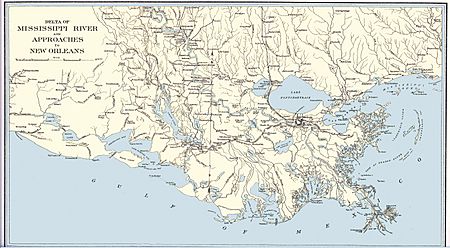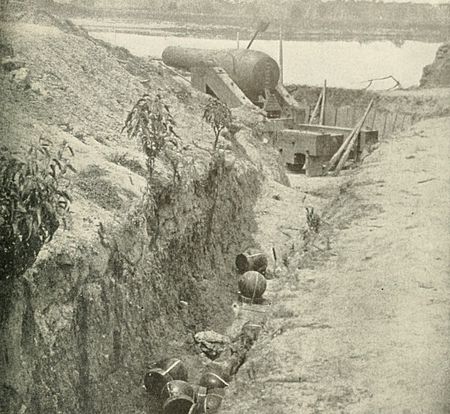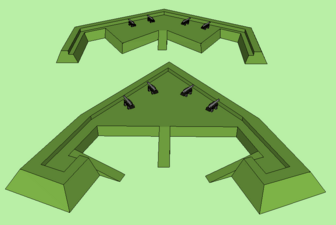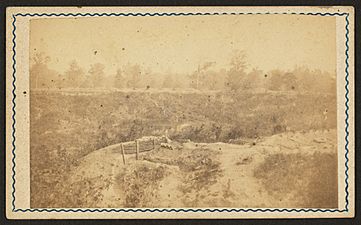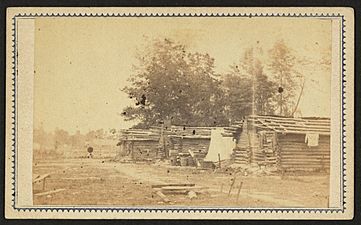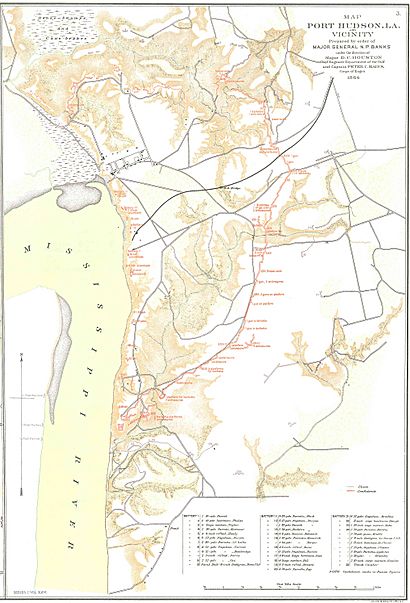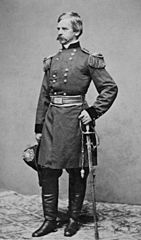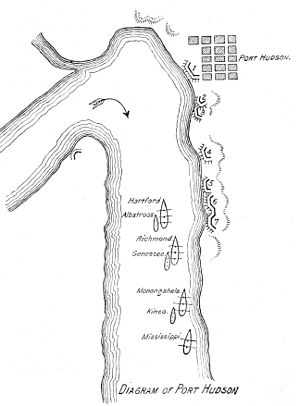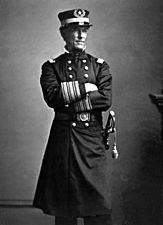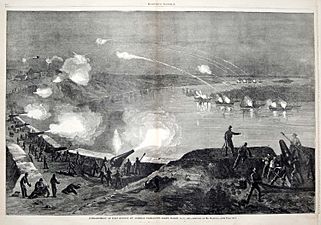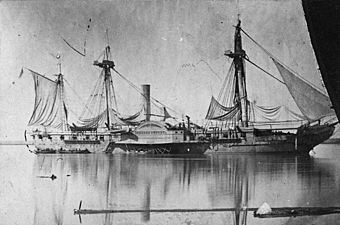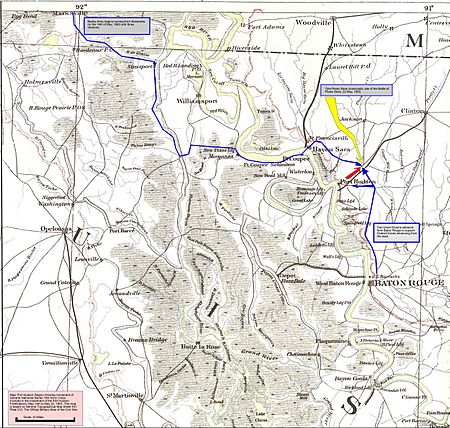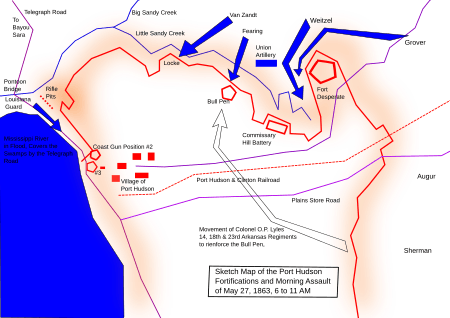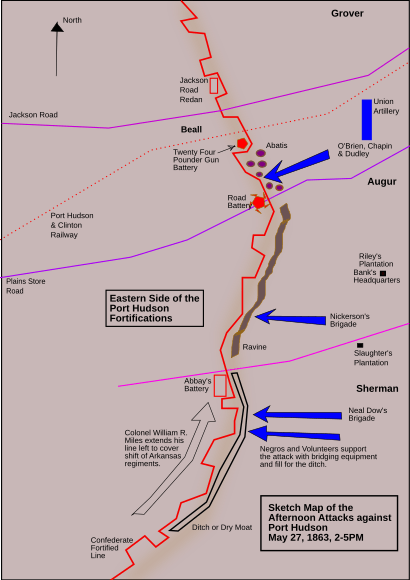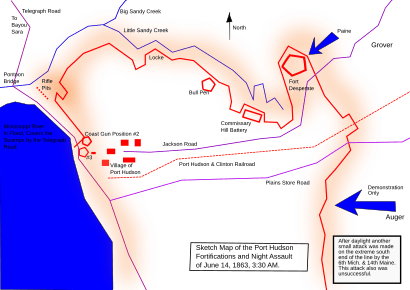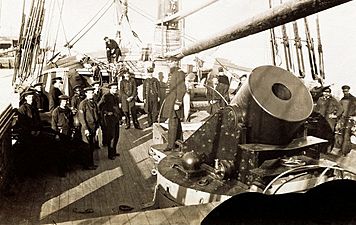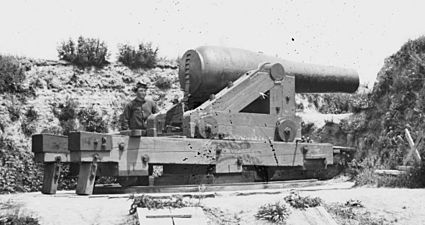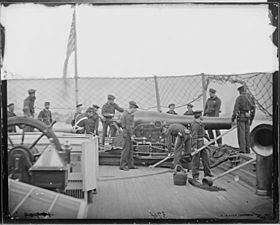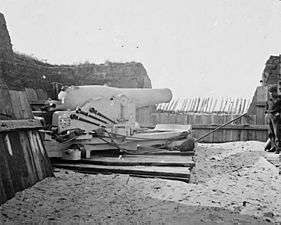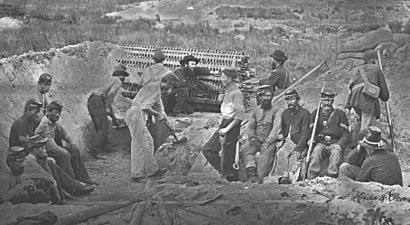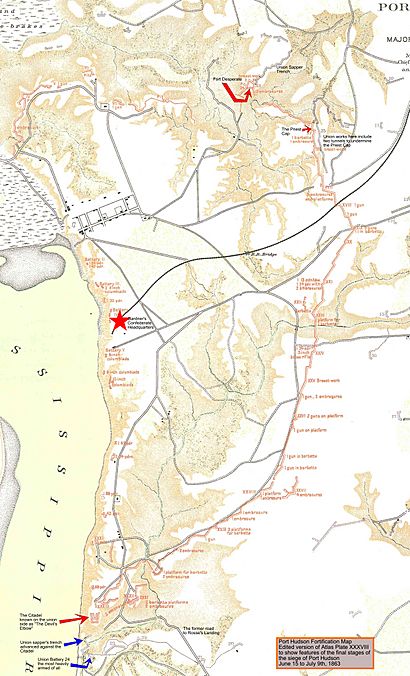Siege of Port Hudson facts for kids
Quick facts for kids Siege of Port Hudson |
|||||||
|---|---|---|---|---|---|---|---|
| Part of the American Civil War | |||||||
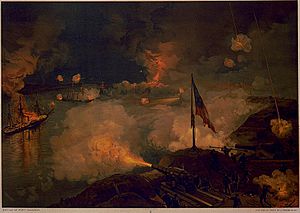 Confederate batteries fire down onto Union gunboats on the Mississippi. |
|||||||
|
|||||||
| Belligerents | |||||||
| Commanders and leaders | |||||||
| Units involved | |||||||
| 19th Corps | Department of Mississippi and East Louisiana, Port Hudson | ||||||
| Strength | |||||||
| ~30,000 – 40,000 | ~7,500 | ||||||
| Casualties and losses | |||||||
| ~5,000 killed and wounded ~5,000 died of disease |
~750 killed and wounded 250 died of disease 6,500 surrendered |
||||||
The Siege of Port Hudson, in Louisiana, was a major event during the American Civil War. It took place from May 22 to July 9, 1863. This battle was the last big step in the Union army's plan to take back control of the important Mississippi River.
While Union General Ulysses S. Grant was attacking Vicksburg further up the river, General Nathaniel P. Banks was told to capture Port Hudson. This was a strong Confederate fort on the lower Mississippi. When his first attack failed, Banks started a long siege that lasted 48 days. This was the longest siege in U.S. military history at that time.
A second attack also failed. The Confederate commander, General Franklin Gardner, only surrendered Port Hudson after Vicksburg fell. With Port Hudson captured, the Union gained full control of the Mississippi River. This meant they could travel from the Gulf of Mexico all the way through the southern states.
Contents
Why was Port Hudson so important?
Controlling the Mississippi River
From the very start of the American Civil War in 1861, both the Union and Confederates wanted to control the Mississippi River. The Confederates needed it to move important supplies. The Union wanted to block this route and split the Confederate states.
A key part of the river for the South was where the Red River joined it. The Red River was the main way the Confederacy moved supplies between its eastern and western parts. Things like salt, cattle, and horses traveled east. Soldiers and weapons moved west.
In 1862, the Union started to gain control of the Mississippi from both ends. From the river's mouth, a Union fleet led by David Farragut captured New Orleans. Another Union fleet took Memphis, Tennessee. To protect their middle section of the river, the South built strong forts at Vicksburg and Port Hudson.
General P. G. T. Beauregard first suggested fortifying Port Hudson in March 1862. He saw it as a good defense point. In August 1862, Confederate General John C. Breckinridge and 4,000 men occupied Port Hudson. Soldiers arrived on August 15, 1862.
Historian John D. Winters said that Port Hudson was one of the strongest spots on the river. Its high bluffs allowed cannons to control the entire river. It was a very strong natural defense.
Political pressure to open the river
The Union's push to capture Port Hudson also came from politics. After elections in November 1862, President Abraham Lincoln faced pressure. People in states like Ohio, Indiana, and Illinois were worried. They needed the Mississippi River open for trade. If it stayed closed, some feared these states might leave the Union.
This threat made Lincoln act. General Nathaniel Banks was sent to New Orleans. The Union's top general, Henry Halleck, told Banks that Lincoln saw opening the Mississippi as the most important military goal. Banks and his troops sailed for New Orleans in December 1862.
By May 1863, Union forces began their big plan. General Ulysses S. Grant attacked Vicksburg in the north. General Nathaniel Banks attacked Port Hudson in the south. They hoped to control the entire river.
Building a strong fort
Port Hudson was built on an 80-foot bluff on the east bank of the Mississippi. It was about 25 miles upriver from Baton Rouge. The area had very rough land, with deep, wooded ravines and swamps. This made it a natural fortress.
The town itself was small, with only a few buildings. A railroad connected Port Hudson to Clinton, 19 miles away. But this railroad was old and could not carry many troops or heavy cannons. This made it hard to defend Port Hudson without river access.
Engineers planned the defenses. They decided on a line of seven `lunettes` (U-shaped forts) facing the river. These would hold cannons.
However, General Breckinridge soon left with most of his troops. Only 1,500 men stayed to work on the forts. They had one large 42-pounder cannon and two 32-pounders. These were manned by former sailors.
On August 29, 1862, General William Beall took command of Port Hudson. That same day, the Union Navy started testing the fort's guns. The USS Anglo-American tried to pass Port Hudson. It was hit many times but could not fire back.
Union Commander David Dixon Porter then attacked Port Hudson with the USS Essex and Anglo-American on September 7. The Union ships did little damage. But the Essex was badly hit. Porter thought Port Hudson had many heavy guns, which was an overestimate.
During a quiet period, General Beall slowly improved the forts. But this work was slow because Union forces controlled parts of the river. Also, the rail and road system was poor. Confederate President Jefferson Davis realized connecting the railroad to Jackson, Mississippi would help. But a lack of iron and transport made it impossible.
Poor supply lines, hunger, and disease were constant problems for Port Hudson. Soldiers often went hungry. Private Robert D. Patrick wrote, "I have been almost starved." At the same time, trade increased at Port Hudson. It became the only link to areas west of the Mississippi. This tied up even more of the fort's limited transport.
New commanders take charge
| The New Commanders |
|---|
|
|
Union General Nathaniel P. Banks arrived in New Orleans on December 14, 1862. He brought 31,000 new soldiers. This more than doubled the Union's strength in the area. Banks ordered his troops to take back Baton Rouge.
The Confederates reacted by sending a new general to Port Hudson. Major General Franklin Gardner arrived on December 27, 1862. Gardner was a skilled officer. He quickly reorganized the defenses at Port Hudson. He focused on making the heavy guns more effective. He also built more earthworks using packed earth.
Gardner improved supplies and built protected roads. This helped move troops quickly to threatened areas. His energy made him popular with his soldiers.
Meanwhile, General Banks was slow to act in New Orleans. He was more interested in politics than leading armies. Rear Admiral David Farragut of the U.S. Navy grew impatient. In March 1863, Farragut decided to attack Port Hudson without the army.
Farragut's fleet attacks Port Hudson
Farragut gathered his fleet by March 13, 1863. It included four large warships and three gunboats. His flagship was the USS Hartford. The ships were tied together in pairs for the attack. The USS Mississippi followed alone.
Farragut prepared his ships for a night attack. He painted gun decks white to see better. He also tied anchor chains to the sides of the ships for extra armor.
The Confederate fort was ready. They had noticed more Union ships downriver. They had over twenty cannons covering the river. Some batteries used `heated shot`, which was very effective against wooden ships. They also had piles of pine wood ready to light up the river at night.
At 11:20 pm on March 14, 1863, the first rocket was fired. This signaled Farragut's fleet was approaching. The battle began. The Union fleet moved upriver, firing their cannons. The Confederate guns on the bluffs had trouble aiming at the ships. The Union ships stayed close to the shore.
Smoke from the cannons and pine fires filled the valley. The Hartford and Albatross ran aground. But they managed to get free and pass the last Confederate guns by 12:45 am.
The other ships were not so lucky. The Richmond was hit hard. It lost power and drifted back downriver. The Monongahela and Kineo also ran aground. They were damaged and drifted back.
The Mississippi was last and also ran aground. It was a big target and was hit many times. The ship caught fire. Captain Smith ordered it abandoned. The Confederates cheered as the ship burned and drifted away. At 5:05 am, the Mississippi exploded. The explosion was seen nearly 80 miles away in New Orleans.
Even though the Hartford and Albatross passed upriver, General Gardner saw this as a victory. The Confederates had few casualties. The Union fleet had many more.
Banks's army moves against the fort
After the naval attack, Banks took his 17,000 troops back to Baton Rouge. Their morale was low. Banks was under pressure to show progress. He launched a campaign in western Louisiana. He gained control of Alexandria and a spot on the Red River.
What finally made Banks attack Port Hudson directly was news of reinforcements. He also heard that many Confederate troops had left Port Hudson for Vicksburg.
On May 11, 1863, Union troops began building bridges. Colonel Benjamin Grierson's cavalry led the advance. Banks planned a `pincer movement`. Three army divisions came from the northwest. Two divisions came from the south. They would meet and surround Port Hudson.
On May 21, one of Banks's divisions met Confederates at the Battle of Plains Store. The Confederates were pushed back. By May 22, Banks's forces, which grew to 30,000 to 40,000 men, had surrounded Port Hudson. Banks hoped to quickly capture the fort. Then he could help Grant at Vicksburg.
The fighting and siege
The first big attack
Sieges are very difficult military operations. General Gardner reinforced his lines. He moved cannons from the river side to the east side. This faced the Union forces. He also had troops outside the fort to slow the Union advance.
Because of these delays, the Union infantry attack was set for May 27, 1863. This gave Gardner enough time to complete his defenses. He also moved artillery to face the Union army.
Morning attacks by Weitzel
General Banks planned the attacks. Many of his officers thought a simple assault would not work. But Banks wanted to end the siege quickly. He believed his 30,000 troops could easily defeat Gardner's 7,500.
Four attack groups were formed. Banks did not set a specific time for the attacks. He told commanders to start "at the earliest hour practicable." This meant the attacks were not coordinated.
The naval bombardment began the night before. Land batteries fired for an hour. General Godfrey Weitzel's divisions attacked at 6 am. They moved through thick ravines. They were caught in a crossfire from three Confederate positions. Thick plants and obstacles also stopped their advance. Union troops suffered many casualties.
General William Dwight then ordered the 1st and 3rd Louisiana Native Guard to attack. These were African-American troops. They were not expected to lead the attack. But Dwight wanted to break through.
These troops advanced under heavy fire. They faced rifles, field artillery, and heavy cannons. Captain Andre Cailloux, a free black citizen, led them bravely. He gave orders in English and French. Cailloux was killed by artillery fire. The attackers suffered heavy losses and had to retreat. This brave advance showed that black troops could fight well under fire.
Other Union attacks also failed. The fighting on the northern side of the fort ended by noon.
Afternoon attacks by Sherman
While fighting raged in the north, General Thomas W. Sherman lined up 30 cannons. He bombarded the eastern side of the fort. Sharpshooters aimed at Confederate artillery crews. This had some success.
But General Banks ordered Sherman to advance his troops. Sherman began the attack around 2 pm. These attacks faced fewer natural obstacles. However, the Confederates had built stronger defenses here. They had a dry `moat` and `abatis` (cut-down trees) in front of their walls.
Union attackers carried axes, poles, and bags to fill the ditch. Confederates used cannons that fired `canister` (cans filled with scrap metal). Colonel William R. Miles, the Confederate commander, also gave each soldier three rifles. This greatly increased their firepower.
When Union infantry got within 200 yards, they faced a hail of fire. Few made it within 70 yards. Union commanders Sherman and Dow were wounded. At 5 pm, the fighting ended. None of the Union attacks reached the Confederate walls.
The last infantry attack
The Confederates felt confident after defending their lines. General Gardner improved his defense system. He divided the forts into defense zones. Engineers strengthened each area. They improved cannon positions and dug protective pits for artillery.
They used spent bullets and scrap metal to make new cannon rounds. Heavy cannons facing the river were moved to fire on Union positions. One 10-inch `columbiad` cannon was so effective, Union troops called it the "Demoralizer."
Confederates also placed `land mines` (called "torpedoes") in front of their lines. These were unexploded mortar shells. `Sniper` positions were set up. These methods improved defense. But the garrison was short on everything except gunpowder. Food shortages led to soldiers deserting.
On the Union side, Banks was determined to continue the siege. He called for all available resources. Nine new regiments arrived by June 1. Eighty-nine field guns were brought in. Naval guns from the USS Richmond were also added. These were powerful 9-inch `Dahlgren` cannons.
The second major attack began with heavy shelling on June 13, 1863. It lasted an hour. Banks then demanded Gardner surrender. Gardner replied, "My duty requires me to defend this position, and therefore I decline to surrender."
Banks continued the bombardment. He ordered a three-part infantry attack for 3:30 am on June 14. But a lack of a clear plan and heavy fog caused confusion. The attack failed. It resulted in many more Union casualties. After this, the Union focused on bombardment and siege tactics.
Final stages of the siege
After the last attack, General Banks asked for volunteers for a special assault group. A unit of 1,036 men was formed. They trained to breach the Confederate lines. Colonel Henry Warner Birge volunteered to lead them.
Regular siege operations were led by Captain John C. Palfrey. He focused on three areas: Fort Desperate, the Priest Cap, and the Citadel. They used `sapping`, which means digging zigzag trenches. These trenches helped isolate and attack enemy forts. `Sharpshooter` positions were also built.
Union cannons were placed on the west bank of the Mississippi. This completely surrounded Port Hudson with artillery. Union forces also raided enemy trenches. Some Union troops used fast-firing `Merrill carbines` for these raids. On June 26, a general bombardment began. It disabled most of the Confederate artillery.
The Union also dug three `mines` under the Confederate works. They planned to fill these with powder and explode them. This would create gaps for an infantry assault.
The Confederates fought back. They used a locomotive to power a mill. This gave them cornmeal. They reused spent shells for new ammunition. They also added more trenches, obstacles, and bunkers. The Priest Cap had a complex defense system. It even used telegraph wire to trip attacking infantry.
Confederates also launched raids. On June 26, they raided a Union trench, taking prisoners and supplies. They also used improvised hand grenades. These raids annoyed Banks but could not break the siege.
The siege caused hardship for both sides. But by early July, the Confederates were in much worse shape. They had almost no food or ammunition left. Many soldiers were sick or had deserted.
When General Gardner learned that Vicksburg had surrendered on July 4, 1863, he knew his situation was hopeless. He negotiated the terms of surrender. On July 9, 1863, the Confederates surrendered. This ended the 48-day siege. It was the longest siege in U.S. military history.
Captain Thornton A. Jenkins accepted the surrender. Admiral David Farragut was in New Orleans at the time.
What happened next?
The surrender of Port Hudson and Vicksburg gave the Union full control of the Mississippi River. This cut off communication and trade between the eastern and western Confederate states.
Both sides had many casualties. The Union lost between 4,700 and 5,200 men in battle. Another 4,000 died from disease or sunstroke. Gardner's forces had about 900 casualties from battle and disease.
Banks gave generous terms to the Port Hudson soldiers. Enlisted men were sent home. Sick and wounded soldiers received Union medical care. About 5,935 Confederate soldiers were released. Officers were sent to prison camps.
The siege also boosted the reputation of black soldiers. The brave advance of the Louisiana Guard on May 27 was widely reported. Captain Robert F. Wilkinson wrote that black troops "fought & acted superbly." General Banks praised their performance in his report.
The New York Times wrote that these "raw troops" faced a "most awful ordeal." They said it was "no longer possible to doubt the bravery and steadiness of the colored race." These reports helped recruit more free black men into the Union army. By the end of the war, nearly 200,000 black soldiers had served.
The siege also affected Banks's political future. If Port Hudson had fallen earlier, Banks might have taken command of Grant's siege at Vicksburg. He could have become a hero. But Vicksburg fell first. Grant gained fame and later became president.
Banks then focused on economic plans. He wanted to reopen trade with Europe. He also started the Red River campaign, a military trip into eastern Texas.
After the war, some soldiers received the Medal of Honor for their actions at Port Hudson. These included George Mason Lovering and future Wyoming Governor Francis E. Warren.
Protecting the battlefield
The Civil War Trust and its partners have helped save 256 acres of the Port Hudson Battlefield. The Port Hudson State Historic Site has steep riverside areas with original cannon positions. There is also a museum with displays and maps.


